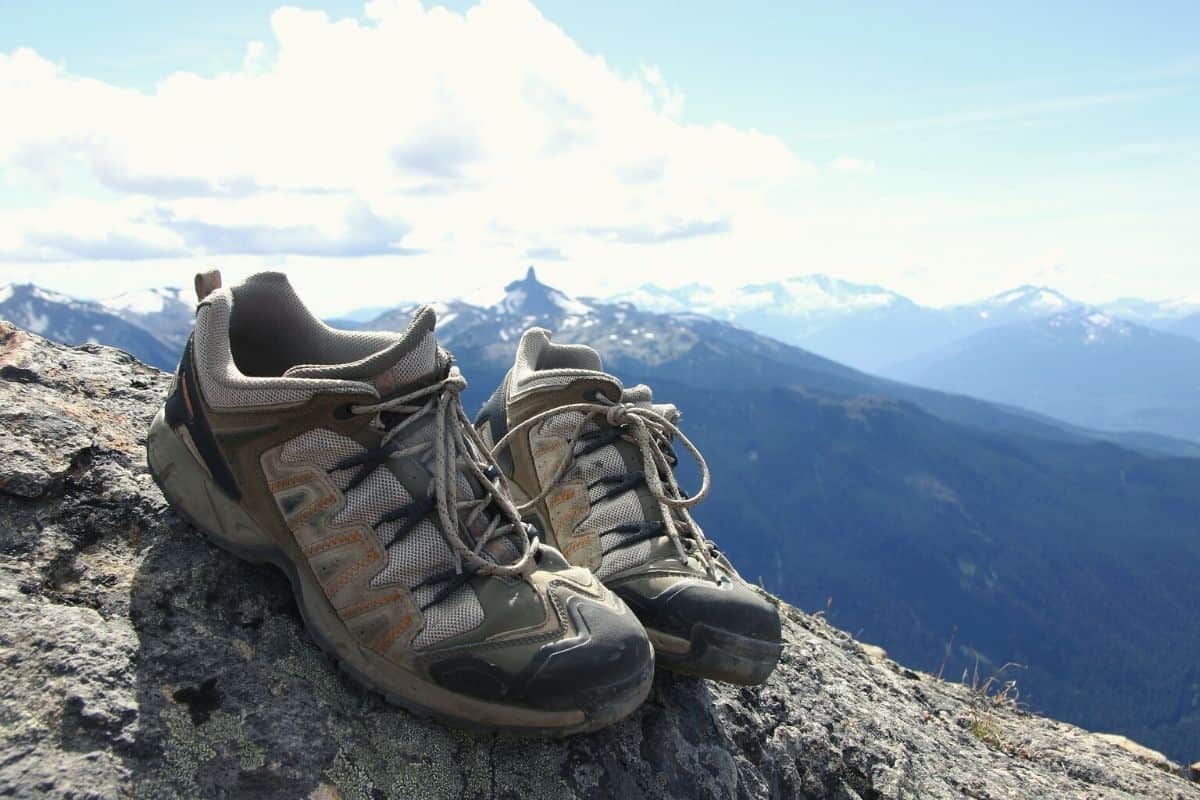Heavy hiking boots can lead to fatigued legs long before you’ve reached the trail’s end. It’s no small wonder, that in recent years, more and more hikers have made the shift from burly hiking boots to lighter shoes. Hiking shoes are now recognized as the ideal solution for hikers who want to enjoy most of the benefits of a hiking boot, but without the weight.
In this post, we’ll introduce you to a selection of our favorite lightweight and ultralight models, and explain why we think the Salomon X Ultra 4 GTX is the best overall hiking shoe on the market. In addition, we will explain what features to weigh up when choosing a good hiking shoe for your needs.
Do
Don’t
Table of Contents
At a Glance: Quick Recommendations
-
Editor’s Choice:
Salomon X Ultra 4 GTX
“An incredibly comfortable hiking shoe that excels in virtually any terrain.” -
Best Shoes for Backpacking:
La Sportiva Spire
“One of very few hiking shoes we’d trust on a multi-day adventure.” -
Best Value:
Vasque Juxt
“A great shoe for the price. It has a few shortcomings but matches its pricier peers in most important metrics.” -
Best Ultralight Hiking Shoe:
Altra Lone Peak 7
“Not the best performer in technical terrain but featherlight and a great pick for lovers of zero-drop shoes.” -
Best for Scrambling:
La Sportiva TX4
“An approach shoe that’s comfortable enough to put in multiple miles on the trails.” -
Honorable Mention:
Danner Trail 2650
“A waterproof hiking shoe that looks good enough to wear to work!” -
Best for Summer:
Merrell Moab 3
“A long-term favorite of hikers everywhere for hiking in hot weather.” -
Best Hiking Shoes for Comfort:
HOKA ONE ONE Speedgoat 5 GTX
“Not ideal for technical trails, but a worthwhile option if you want the most comfortable hiking shoes your money can buy.” -
Best Traction and Grip:
Adidas Terrex Swift R3 GTX
“Our preferred hiking shoes for hikes in muddy or loose terrain.” -
Best for Wide Feet:
Keen Targhee III
“A little heavy and cumbersome, but great hiking shoes if your feet are on the wider side.” -
Best Budget:
Columbia Redmond
“Similar performance to the Moab 2 but at a much friendlier price.”
Which are the Best Hiking Shoes?
Over the last few years, our testers have walked 100s of miles to develop our shortlist of the best trail shoes below, putting each shoe through its paces in locations as diverse as the Sangre de Cristo Mountains, the Italian Alps, and the English Lake District.
- Salomon X Ultra 4 GTX
- La Sportiva Spire GTX
- Vasque Juxt
- Altra Lone Peak 7
- La Sportiva TX4
- Merrell Moab 3 Ventilator
- HOKA ONE ONE Speedgoat 5 GTX
- Adidas Terrex Swift R3 GTX
- Keen Targhee III
- Columbia Redmond
- Danner Trail 2650
Salomon X Ultra 4 GTX
Editor’s Choice
Over the past few years, the Salomon X Ultra 4 GTX (click here for women’s version) has established itself as the top-rated lightweight hiking shoe in the business, and a worthy successor to the hugely popular Salomon X Ultra 3 GTX.
At a little over a pound and a half, these are among the lightest waterproof hiking shoes out there. What’s even better is that they don’t forsake much in the way of stability and comfort.
They boast an EVA midsole, which provides ample cushioning, and a contoured Ortholite insole. Our reviewers found the Contragrip outsole just as grippy as most varieties of Vibram on rock and slippery, loose terrain. They also appreciated the protective toecap and minimalist rand, which come in handy when walking in scree or otherwise rocky ground.
The X Ultra 4 GTX incorporates a Quicklace system with a plastic lock, four eyelets, and Kevlar laces. The laces slide into the apertures easily and equalize tightness as you walk. There is a mesh pocket at the top of the tongue where you can stow the excess laces, so they won’t be dangling around and annoying you.
These Salomon shoes have a few other features worth mentioning. Firstly, a molded shank between the outsole and midsole offers extra lateral stability. Secondly, a wide forefoot that provides ample support while allowing your toes to spread naturally. Finally, a large brake lug at the back of the outsole prevents the heel from sliding out when going downhill.
There are lighter shoes available, but none that offer the same performance as these. Our opinion? The best lightweight waterproof hiking shoes out there.
The main differences between the Salomon X Ultra 4 GTX and the Salomon X Ultra 3 are that the Ultra 4 has an upgraded chassis and support system, and a slightly thinner upper to boost ventilation and reduce weight. In isolation, none of these tweaks are worth the extra splurge, but our testers agreed that combined they make a noticeable difference.
Key Features
- Waterproof leather uppers feature breathable polyester mesh panels to keep feet comfortable
- Gore-Tex waterproof bootie liners let feet breathe while protecting them from the elements, keeping feet dry and comfortable
- Mudguards and integrated rubber toe caps provide protection from roots and rocks
- ADV-C chassis is light and stable underfoot, maximizing motion control for an efficient and responsive ride without excess weight
- Compact and secure lace system with 1-pull tightening for easy-on/off; lace pockets provide easy storage
- Active Support “mobile wings” help keep your feet in place by conforming to their shape and volume
- Contagrip® MA outsoles provide great grip on rock and enhanced traction in loose terrain
- Luxuriously soft polyester lining wicks moisture away from feet
- Weight: 1 lb. 11.5 oz.
What Others Thought
- Ryan Heutter, Outdoor Gear Lab: “…these are the shoes to get if you’re after lightweight performance in challenging hiking terrain.”
- Alex Foxfield, BASE Magazine: “A very stable and protective hiking shoe for fast and light mountain adventures that grips soggy ground just as well as dry rock.”
- Mallory Paige, Field and Stream: “…excelled in a variety of settings and provided all day comfort, traction, and stability during our tests.”
PROs
- Great water resistance
- Aggressive traction
- Quite versatile
- Lightweight
- Excellent support and stability
CONs
- Quicklace system isn’t for everyone
- While we loved the added support provided by the new X Ultra 4, the high collar will prove uncomfortable for some.
Bottom-Line: Everything you could ask for in a waterproof hiking shoe and a solid option for backpacking, too.
La Sportiva Spire
Best Shoes for Backpacking
The La Sportiva Spire (click here for women’s version) are lightweight hiking shoes that are built to withstand a little more use and abuse, making them ideal for thru-hikes or backpacking trips.
Weighing in at just under two pounds, the Spire is the second heaviest shoe on our list. For our testers, however, this wasn’t a dealbreaker. In return for those extra few ounces you get a far burlier, sturdier, more durable, and supportive shoe than you’ll come across at a lighter weight.
The main differences between the Spire and other trail hiking shoes on our list are its extra-beefy midsole and stiffer feel. The midsole provides all the protection and cushioning needed when carrying heavy loads or racking up high mileage on the trails, while that added rigidity all but eliminated calf strain on ascents.
Our testers were also smitten with the Spire’s breathability, light but effective protection, and extra-aggressive tread, which provided awesome traction and grip on loose and wet terrain.
The Spire aren’t the cheapest hiking shoes out there. However, their high-quality build and long-term performance make them well worth the added outlay.
Key Features
- Innovative Nano-Cell™ 2.0 Technology upper wraps the foot in protection while allowing maximum breathability and waterproof protection
- EVA midsole with side ventilation outlets in TPU
- Vibram XS Trek outsole with Impact Brake System for reliable grip on hard and soft terrain
- Gore-Tex® Surround™ Technology allows 360-degree breathability without compromising the waterproof nature of the shoe
- Weight: 1lb. 12.8 oz.
What Others Thought
- Ebony Roberts, Treeline Review: “If we had to pick one shoe to take us through most situations comfortably and safely, this is the one.”
- Casey Handley, Clever Hiker: “…surprisingly light for how much confidence they provide on the trail.”
- Gear Junkie: “…waterproof and weigh less than one pound each, yet include unique features to boost durability and utility on the trail.”
PROs
- Beefy midsole
- Grippy Vibram sole
- Gore-Tex surround
- Breathable
- Tough
CONs
- Pricey
- Quite heavy
- Overkill for casual trails
Bottom-Line: Comfortable, well-made, and tough enough to take on the gnarliest and longest of backpacking trails.
Vasque Juxt
Best Value
The Vasque Juxt has its limitations but is one of the most versatile lightweight trekking shoes you will ever own. It’s comfortable enough for long days on the trails, nimble enough for scrambling, tough enough for short backpacking trips, and stylish enough for the odd night on the town!
The only time we wouldn’t wear the Juxt is on a trail run. (For hiking shoes that can moonlight as trail runners, check out the Speedgoat 5 and Lone Peak 7).
The Juxt is relatively lightweight (1 lb. 13 oz.) but boasts a burly 1.6mm suede leather upper, plenty of ankle padding, and a TPU plate in the midfoot for added support. This was our first spin in a shoe with a Vibram Off-The-Grid outsole, and we found it up there with the MegaGrip used in the TX4, Speedgoat 5, and Danner Trail 2650.
Vasque did a great job with the lacing system, too. It includes eight alternating webbing loops and traditional eyelets that make it easy for you to fine-tune the tightness of the shoe.
The Juxt aren’t waterproof, but the suede upper does enough to keep your feet dry in light rain.
Key Features
- Polyurethane-coated suede leather upper material offers durability, flexibility, and water resistance; molded rubber toe caps provide excellent protection for feet and shoes
- Close-to-toe lacing offers a fully tunable, secure fit
- Wicking nylon linings absorb excess sweat and disperse it quickly for fast drying
- Removable dual-density footbeds add cushioning to compression-molded EVA midsoles for all-day cushioning and shock absorption
- Thermoplastic urethane shanks deliver support and add rigidity for a stable ride
- Weight: 1 lb. 13 oz.
What Others Thought
- Ross Robinson, Outdoor Gear Lab: “…a capable hiking shoe covering all the bases, minus water resistance, at an impressively approachable list price.”
- Seal Grinder PT: “…some of the most comfortable shoes I have ever had.”
PROs
- Nice and snug fit
- Flexible forefoot is good for day hiking with medium loads
- Extra support around the ankle makes it ideal for backpacking trips
- Inexpensive, lightweight, and breathable
- Wide enough to wear with chunky hiking socks
CONs
- Not 100% waterproof
Bottom-Line: A fairly priced, breathable, and durable hiking shoe that has a few shortcomings but ticks most of the most important boxes. One of the best budget hiking shoes out there.
Altra Lone Peak 7
Best Ultralight Hiking Shoe
The Altra Lone Peak 7 (click here for women’s version) is one of the best trekking shoes out there, providing the plush cushioning, all-day comfort, and stability needed for thru-hikes and backpacking.
The Lone Peak is a light trail runner that has quickly established itself as a favorite of long-distance hikers thanks to its marshmallow cushioning, featherlight weight, and solid traction.
They weigh a piddly 1 lb. 6 oz., making them the lightest option on our list. Despite this, they pack the beefiest cushioning by far (25mm) and are surprisingly durable and protective. Compared to the Hoka One One Speedgoat, moreover, their lower stack height made them feel more reliable on rocky ground.
On the downside, we found the Lone Peak 7 to be a little too flexible for technical and steep terrain, while some of our testers weren’t impressed by the toe box, which is wider than in most hiking shoes.
This is the only zero-drop shoe on our list. While this means you get more ‘trail feel’ and stability than with a traditional hiking shoe, it also means more strain will be placed on your Achilles tendon and calf muscles. If you’re not accustomed to a low drop, we’d recommend familiarizing yourself with a mid-drop shoe before dropping to zero.
Key Features
- MaxTrac outsole with TrailClaw canted lugs
- Quick-Dry Air Mesh upper
- Balanced Cushioning platform encourages better foot alignment and low-impact landing
- Responsive Altra Ego dual-nature midsole
- Footshape toe box allows toes to spread out naturally to increase stability and comfort
- Weight: 1 lb. 6 oz./640g
What Others Thought
- Heather Balogh Rochfort, REI Expert Advice: “…you’ll be thrilled with the all-around positive updates in the Lone Peak 7.”
- Kelly Floro, The Trek: “…the upgraded outsole is an improvement over previous versions.”
- Nathan Allen, Trip Savvy: “…excellent trail running shoes…they’ve also been some of my favorite hiking shoes.”
PROs
- Very comfortable
- Zero heel-to-toe drop
- Great cushioning
- Ultralight
- Wide toe box (a ‘con’ for some)
- Men’s and women’s versions available
CONs
- Too flexible for tough and technical terrain
- Not waterproof (waterproof version)
Bottom-Line: A lightweight trail running shoe that can happily moonlight as a hiking shoe thanks to its tough build, grippy sole, and plush cushioning.
La Sportiva TX4
Best for Scrambling
The La Sportiva TX4 (click here for women’s version) is our favorite hiking shoe for hiking in more technical terrain. As an approach shoe, it’s a different beast to the options above and below, but this also makes it a standout performer on any hikes that involve rock scrambles, boulder hopping, or scree-walking.
The TX4 is a burly shoe, combining a suede upper with a 1.5mm PU rand to deliver superior ruggedness to almost any other hiking shoe out there. They aren’t waterproof, but that suede upper and a 360-degree rand do a good job of keeping the wet stuff out in all but the heaviest of downpours.
The TX4’s Vibram outsole is less aggressive than others on our list, but the flatter profile means it smears on rock almost as well as an out-and-out climbing shoe. That burly rand also protects your toes from bumps and bangs and the smooth “climbing area” of the toe allows for precise footwork on tricky scrambles.
All of the above makes the TX4 a highly versatile shoe. While many of the options on our list are better suited to well-formed trails, the TX4 will serve you well on anything except backpacking trips, for which we’d want a little more cushioning and a deeper tread to improve traction on loose or muddy terrain.
Key Features
- 1.5 mm PU TechLite rand and rubber toe for extra protection and abrasion resistance
- Vibram MegaGrip sole with a climbing zone at the toe and Impact Brake System at the rear for tackling technical terrain
- STB Control System provides structure, support, and stability
- Ortholite Approach 4 mm insole
- Weight: 1 lb. 10 oz.
What Others Thought
- Timothy Carlson, Hike the Planet: “…hands down the most comfortable hiking shoe that I have ever worn.”
- Rik Henderson, Mud and Routes: “stuck to everything from rocky outcrops and greasy slabs, to precarious bog and grassy verges.”
- Jenny Abegg, Switchback Travel: “…the TX4’s added protection, longevity, and waterproofing are worth the small weight penalty.”
PROs
- Awesome on rock
- Lightweight
- Tough
- Highly protective 360-degree rand
- No break-in period
CONs
- Suede upper restricts breathability
- Not the grippiest on muddy trails or loose ground
- Not waterproof (GTX version available)
Bottom-Line: Our go-to when taking on more technical terrain.
Danner Trail 2650
Honorable Mention
The Danner Trail 2650 is a casual hiking shoe that offers a nice balance between comfort, weight, and durability. While not the best shoe for technical terrain, it’s a solid option for shorter hikes and hikers who want sneaker-like comfort.
The Trail 2650 require zero break-in period and offer exceptional comfort straight from the box. This is largely thanks to their ultra-soft and breathable textile/leather upper and cushy PlyoGo EVA midsole. Our testers rated them among the most comfortable on this list, though did warn that the midsole offers less underfoot protection than other options.
In terms of traction and grip, the Trail 2650 are a mixed bag. The Vibram MegaGrip outsole offers excellent grip on rock and slick surfaces, but the tread pattern is less aggressive, meaning it doesn’t bite as well into mud or loose ground. On regular, well-maintained trails, this won’t be an issue, but off-trail or in gnarlier conditions, a shoe like the Terrex or Spire is a safer bet.
Key Features
- GORE-TEX® waterproof liner
- Suede uppers
- Vibram® 460 Outsole
- Ultra-lightweight Danner PlyoGo EVA midsole
- Trailguard TPU shank
- EXO Heel System
What Others Thought
- Ryan Huetter, Outdoor Gear Lab: “…scored reasonably well in all of our metrics, most notably in comfort.”
- Philip Werner, Section Hiker: “…comfortable, agile, and requires very little break-in time.”
- Sarah Nelson, Switchback Travel: “Excellent comfort, durability, and protection in an impressively lightweight build.”
PROs
- Suitable for both on and off-trail use
- Incredibly comfortable as long as you choose the right fit
- No break-in period
- Weigh just 1 lb. 8 oz./680g
CONs
- Not the best for extremely rough terrain
- Fall short on traction
Bottom-Line: Well-made and among the most comfortable hiking shoes we’ve worn, but too casual for gnarlier terrain or longer hikes.
Merrell Moab 3
Best for Summer
The Merrell Moab 3 (click here for women’s version) is a great choice of shoe for hikers who anticipate hiking in dry, hot conditions thanks to its peerless ventilation and breathability.
The Moab is on one of the most popular (men’s and women’s) hiking shoes on the market and has been since the first iteration was released over 20 years ago. The reasons for this are simple: it’s relatively light, comfortable, grippy, and a cut above the rest on hot days on the trails.
The Moab 3 are made with suede and mesh uppers with a mesh interior lining that allows ample airflow. The unique Merrell air cushion in the heel absorbs shock and adds stability, while the Vibram TC5+ outsole provides awesome grip on rock, mud, and grittier trail surfaces. A nylon arch shank provides extra support and leverage on steep ascents, while the springy EVA midsole provides additional stability and comfort.
At 1 lb. 15 oz., the Moab are on the heavy side, but our testers agreed that they’re also one of the most comfortable hiking shoes out there and well worth the added ounces, particularly if you do most of your hiking in hot and dry climates.
They aren’t the most durable hiking shoes available, so are better suited to well-trodden, established trails.
If you’d prefer a little more water resistance, be sure to check out the waterproof version.
Key Features
- Vibram TC5+ outsole provides improved performance on challenging terrain
- Kinetic Fit ADVANCED removable contoured footbed with reinforced heel provides added cushioning
- Molded nylon arch shank
- Shock-absorbing Merrell Air Cushion heel
- Lightweight EVA foam midsole
- Weight: 1 lb. 15 oz.
What Others Thought
- John Ellings, Switchback Travel: “…if you put a premium on soft cushioning and comfort, I wholeheartedly recommend the Moab 3.”
- Philip Werner, Section Hiker: “a good choice if you’re looking for stable and supportive hiking shoes.”
- Gabi Reyes-Acosta, Treeline Review: “the Moab 3s provide a comfortable and secure walking experience with little to no break in time.”
PROs
- Highly breathable
- Grippy outsole
- Protective toe cap
- Ideal for day hikes on mellower trails
- Comfortable
CONs
- Quite heavy
- Not waterproof (waterproof version available)
- Lack agility of performance shoes like the X Ultra 4
Bottom-Line: Not the most technical or agile, but affordable, comfortable, and the best lightweight hiking shoes out there for hot and dry conditions.
HOKA ONE ONE Speedgoat 5 GTX
Best Hiking Shoes for Comfort
The Hoka One One Speedgoat 5 (click here for women’s version) were unanimously rated the most comfortable hiking shoes in the business by our team of testers.
These lightweight hiking shoes up the stakes in the comfort department by using multiple-density rubber soles that provide added cushioning and shock absorption. Their chunky midsole and thick insole also provide pillow-like cushioning, great underfoot protection, and ample arch support.
We took the Speedgoat 5 GTX for a test drive on a rainy day in England’s Lake District and were impressed by the waterproofing when traipsing through puddles and boggy ground. True to the brand’s word, the midsole was highly responsive and provided great energy transfer, while the wider toe box seemed to add some stability.
The only quibbles we had with this shoe were that its protection is minimalist at best, and it lacked the stiffness, stability, and precision needed on even the low-grade scrambles. In its defense, it wasn’t built for such terrain and performed admirably on more established sections of the trail.
Key Features
- Vibram® Megagrip rubber outsoles with Traction Lug
- 3D-printed overlays provide midfoot support and a secure fit
- Hydrophobic gusseted tongues
- Late stage MetaRocker™
- Midsole features lightweight foam for a more responsive ride
- Strategic tongue cutouts for added breathability
- Weight: 1 lb. 4.6 oz./580g
What Others Thought
- Sam Schild, Treeline Review: “…one of our favorite shoes for hiking, backpacking, and of course, trail running.”
- Michael Lanza, The Big Outside: “…arguably the best shoes out there for trail runners, dayhikers, and ultralight and lightweight backpackers.”
- Jens Jakob Andersen, Run Repeat: “The Speedgoat 5 from Hoka remains your reliable and great-value do-everything trail shoe.”
PROs
- Very grippy outsole
- Great cushioning
- Solid waterproofing
- Nice midfoot support
- Awesome traction
- Great for hiking and trail running
CONs
- Lack stability on steep ground
- Not the most durable
Bottom-Line: Crazily comfortable but lack the burliness and stability of a true hiking shoe.
Adidas Terrex Swift R3 GTX
Best Traction and Grip
The Adidas Terrex Swift R3 GTX (click here for women’s version) are good hiking shoes for anyone seeking a crossover between trail runners and out-and-out, technical hiking footwear.
At 1 lb. 12 oz., this is one of the lighter trail running shoes for hiking out there. Nevertheless, they’re burly enough to deal with just about anything you might encounter on the trails.
A thick rubber rand around the toes provides added protection and a stiffer TPU rand covers the heel, while the EVA midsole provides ample cushioning and protection under the forefoot and arch. Although quite stiff in the midfoot, there’s plenty of flex in the forefoot. This makes it extremely comfortable but provides the stability needed for steeper and uneven ground, even when you’re hauling a heavy pack.
There’s a Gore-Tex liner and a tall, gusseted tongue to keep your feet dry in wet weather. However, our testers felt that the Salomon X Ultra 4 outperformed the Terrex in the waterproofing metric.
The Terrex aren’t as supportive or robust as hiking shoes like the La Sportiva Spire or Salomon X Ultra 4, but they’re among the best hiking sneakers out there for any hiker who prioritizes weight savings, nimbleness, and performance.
Key Features
- Ripstop mesh upper for breathability and light weight and TPU overlays for durability and added support
- GORE-TEX® lining for waterproof, breathable performance
- Speed lacing construction for fast lacing and a snug fit; LACE BUNGEE stows laces to help avoid tangling
- ADIPRENE® under the heel for superior cushioning at impact; Molded rubber toe cap for protection
- TRAXION™ outsole for optimal grip in all directions; Superhigh-traction rubber outsole for optimal grip in wet conditions
- Weight: 1 lb. 12 oz.
What Others Thought
- Ryan Heutter, Outdoor Gear Lab: “…best suited for those who desire a stiff and stable shoe.”
- Pat Kinsella, Advnture: “…armed with a formidable set of features that make them very trail capable.”
- Paul Ronto, Run Repeat: “As long as you give it some time to break into its full potential, this Adidas shoe will not disappoint.”
PROs
- Speed lacing tightens quickly with the pull of a plastic sliding lock
- Best for narrow to medium-volume feet
- The upper is made of ripstop style nylon and has synthetic overlays
- Pronounced heel brake gives you added confidence when going downhill
CONs
- The midsole can prove harsh on longer trail days
Bottom-Line: A winner if you’re looking for something that offers a bridge between trail runners and more traditional hiking shoes.
Keen Targhee III
Best for Wide Feet
The Keen Targhee III (click here for women’s version) is one of the sturdiest hiking shoes on the market, and an ideal pick for hikers with wide and high-volume feet.
It comes with a ¾ length shank that offers added support and less fatigue on long hiking trips. The cushioned cuff extends to the ankles for added comfort, and the substantial EVA foam midsole provides added cushioning.
Our testers love the fact that Keen used nubuck leather, which is naturally waterproof, on the upper, and mesh on the tongue for breathability. They were also impressed by the large rubber rand, which offers extra toe protection against rocks and roots.
All in all, the Keen Targhee III is an excellent investment for those who prefer trekking in aggressive terrain.
Key Features
- Waterproofed nubuck leather and flexible nylon mesh uppers offer ample durability, flexibility, and breathability for comfort on the go
- Secure-fit lace capture system with sturdy nylon webbing eyelets and heel wrap help lock feet to footbeds for increased support
- Metatomical EVA footbeds are shaped to provide ample cushioning and arch support; can also accommodate orthotics
- KEEN.DRY™ waterproof breathable membranes keep feet dry while allowing perspiration to dissipate before it saturates the inside of the shoe
- Webbing pull loops at heel and tongue allow easy entry/exit; padded, gusseted tongues keep out debris and moisture while relieving lace pressure
- Compression-molded EVA midsoles offer shock absorption and padding for all-day comfort
- Weight: 2 lbs.
What Others Thought
- Ryan Huetter, Outdoor Gear Lab: “…provides good performance for those looking to go out and hit their local trails.”
- Joey, Cool of the Wild: “…super comfortable and a highly reliable companion on all but the most challenging terrain.”
PROs
- Great ankle support
- Shank prevents foot fatigue on long hikes
- Large toe rand is good for rocky terrain
CONs
- A little too roomy for narrow feet
Bottom-Line: A supportive, tough, burly hiking shoe at an affordable price.
Columbia Redmond
Best Budget
The Columbia Redmond is a durable and lightweight hiking shoe that is suitable for all kinds of outdoor activities, from day hikes and low-grade via Ferrata to lightweight backpacking trips.
The Redmond has an Omni-Grip sole that provides excellent traction in different terrains. The Techlite lightweight midsole offers long-lasting comfort, high energy return, as well as great cushioning for such fairly priced and light hiking shoes.
The upper is a combination of mesh, suede leather, and webbing. This prevents water from sneaking in while boosting airflow on hot days.
As for waterproofing, the Redmond is equipped with an Omni-Tech membrane. Our testers were skeptical as to whether this would offer the same protection as Gore-Tex, but were impressed by its performance on wet-day hikes.
All in all, the Redmond offers similar performance the Merrell Moab but is a little more affordable. Despite a few shortcomings, this made it the standout winner of our Best Budget Hiking Shoe award.
Key Features
- Omni-Tech™ waterproof breathable seam-sealed membrane bootie construction
- A durable low cut waterproof hiker that provides great traction and comfort
- UPPER: Combination of suede, mesh, and webbing
- MIDSOLE: Techlite™ lightweight midsole for long-lasting comfort, superior cushioning, and high energy return
- OUTSOLE: Omni-Grip™ non-marking traction rubber
- Weight: 1 lb. 14.1 oz.
What Others Thought
- Sarah, Walk Jog Run: “…a fantastic hiking shoe suited to everyday use or general hiking.”
- Sami Kritz, GearWeAre: “…a great choice for the casual hiker.”
PROs
- Outsole is made from Omni-Grip non-marking traction rubber
- Omni-Tech waterproofing
- Wide fit makes them ideal for wide feet
- Multi-directional lugs provide excellent traction
CONs
- Runs small and is a little too narrow for wider feet
Bottom-Line: An affordable, lightweight trail shoe that isn’t as performance-oriented as our top picks but ticks more than enough boxes for the needs of your average hiker
Hiking Shoe Comparison Table
| Product Name | Weight | Waterproofing | Uppers |
|---|---|---|---|
| Salomon X Ultra 4 GTX | 1 lb. 11.5 oz. | Gore-Tex waterproof bootie liners | Waterproof leather, polyester mesh panels |
| La Sportiva Spire | 1 lb. 12.8 oz. | Gore-Tex® Surround™ Technology | Nano-Cell™ 2.0 Technology upper |
| Vasque Juxt | 1 lb. 13 oz. | Water-resistant (not fully waterproof) | Polyurethane-coated suede leather |
| Altra Lone Peak 7 | 1 lb. 6 oz. | Not waterproof (waterproof version available) | Quick-Dry Air Mesh upper |
| La Sportiva TX4 | 1 lb. 10 oz. | Not waterproof (GTX version available) | Suede upper with 1.5mm PU rand |
| Danner Trail 2650 | 1 lb. 8 oz. | GORE-TEX® waterproof liner | Suede uppers |
| Merrell Moab 3 | 1 lb. 15 oz. | Not waterproof (waterproof version available) | Suede and mesh uppers |
| Hoka One One Speedgoat 5 GTX | 1 lb. 4.6 oz. | Waterproof | - |
| Adidas Terrex Swift R3 GTX | 1 lb. 12 oz. | GORE-TEX® lining | Ripstop mesh upper |
| Keen Targhee III | 2 lbs. | KEEN.DRY™ waterproof breathable membranes | Waterproofed nubuck leather |
| Columbia Redmond | 1 lb. 14.1 oz. | Omni-Tech™ waterproof breathable membrane | Combination of suede, mesh, and webbing |
Top Choices by Category
Here are our favorite shoes broken down by the best performers in each consideration category, or continue scrolling to our “How to Choose” section for more detail.
Budget: Merrell Moab 2 Ventilator, Columbia Redmond, Vasque Juxt
Waterproofing: Salomon X Ultra 3 GTX, La Sportiva Spire, Adidas Terrex Swift R3 GTX
Backpacking: La Sportiva Spire and Salomon X Ultra 3 GTX
Comfort: HOKA ONE ONE Speedgoat 4, The North Face 109 GTX, Altra Lone Peak 6
Traction: Salomon X Ultra 4 GTX, La Sportiva Spire, Adidas Terrex Swift R3 GTX
Weight: Altra Lone Peak 7, HOKA ONE ONE Speedgoat 5
Breathability: Merrell Moab 3, Altra Lone Peak 7
Protection: La Sportiva TX4, La Sportiva Spire, Vasque Juxt, Keen Targhee III
Durability: La Sportiva TX4, Vasque Juxt, Keen Targhee III
What to Consider When Looking for Good Hiking Shoes?
If you’re looking for a new pair of hiking shoes, then you want to consider the following features.
- Comfort and support
- Traction
- Weight
- Waterproofing
- Breathability
- Protection
- Durability and Materials
- Lacing Systems
Comfort and Support
Comfort and support should be the foremost considerations when choosing hiking shoes. The degree of comfort and support a hiking shoe provides is mainly determined by the midsole and insole, and to a lesser degree, the shank.
Midsole and Cushioning
The midsole and cushioning play a vital role in comfort levels. The purpose of midsole cushioning is to provide an extra layer of protection from rocks and to absorb shock.
Most midsoles incorporate TPU, EVA, or a combination of both (Danner 2650).
Thermoplastic polyurethane (TPU) is usually found on performance-oriented hiking shoes (La Sportiva Spire and Adidas Terrex). It typically lasts longer than EVA and does a better job of handling heavy loads. EVA midsoles (Juxt, Moab, Ultra, Targhee), on the other hand, are lighter, cushier, and springier.
The bottom line? Go for a firm and more supportive midsole if you like logging serious miles in rougher and uneven terrain, a softer sole if you’ll be walking on well-maintained paths and prefer pillow-like cushioning.
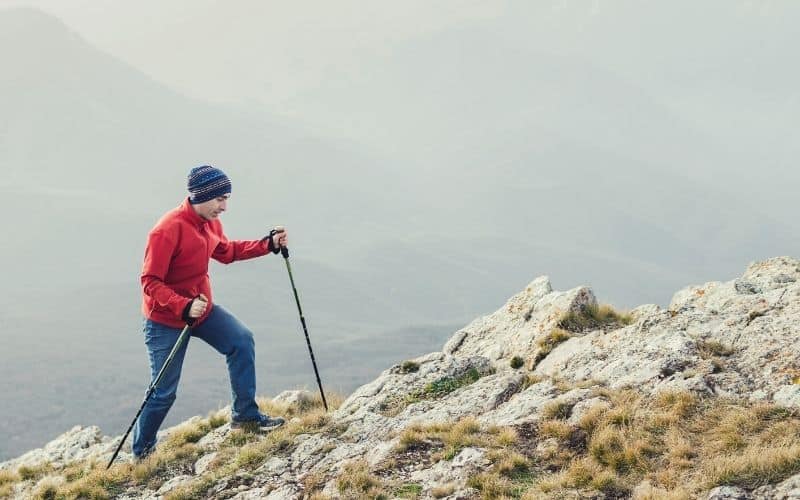
Insoles
Insoles, the inserts attached to the footbed, also play a big role in any shoe’s comfort, particularly as regards cushioning and arch support.
Almost all hiking shoes come with cheap insoles. The good news is that removing and replacing them with a high-quality, aftermarket model specially designed for your feet is easy. The best thing about aftermarket insoles is that they provide an improved fit under the arch. They also offer enough volume to fill out the shoe and added cushioning to improve shock absorption.
The only insoles to receive pass marks from shoes on our list were those in the Salomon X Ultra 4, Keen Targhee III, and La Sportiva Spire.
Shank
The importance of internal support and built-in shanks cannot be stressed enough. While they do lead to a degree of stiffness that might take a little getting used to, they are what separate good hiking and backpacking shoes from ordinary road running shoes or flexy trail runners.
A shank is a semi-rigid insert that fits into the midsole of a shoe to prevent it from being too floppy. It helps to improve traction and provides additional support on steeper ground by preventing the shoe from buckling. While not so necessary on flatter terrain, the benefit of this feature in technical terrain, or when you’re carrying a heavy pack, can’t be overstated.
For flat and less technical terrain, a light and reasonably flexible shoe like the Keen Targhee III or Moab 3 is a great option. When your pack weight is topping the ten-pound mark on longer hikes, a shoe with a stiffer shank like the Salomon X Ultra 4 GTX, Danner 2650, or La Sportiva Spire is a safer bet.
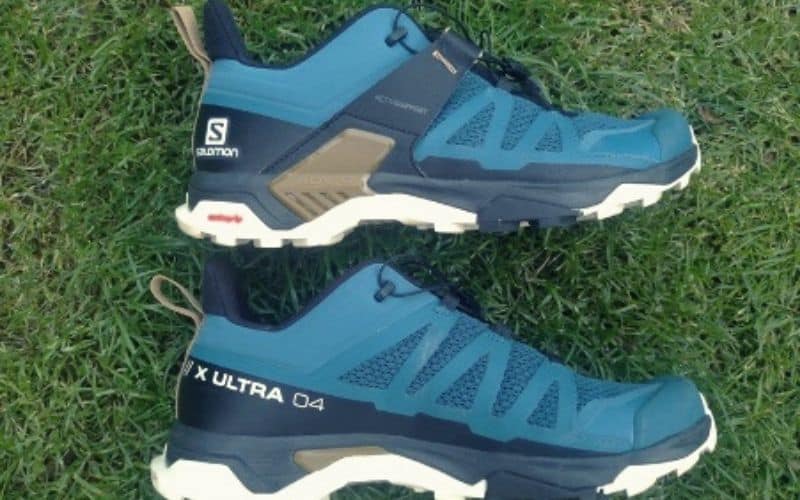
Traction
One of the main reasons for choosing a real backpacking shoe over a flimsy cross trainer is that the former offers improved traction. The patterning of the tread and depth of the lugs in your hiking shoes together provide far superior grip in loose, muddy, and slippery terrain, which helps to prevent falls and slips.
The type of outsole is equally important. Vibram outsoles are generally the most grippy, but Salomon’s Contagrip is also a good choice.
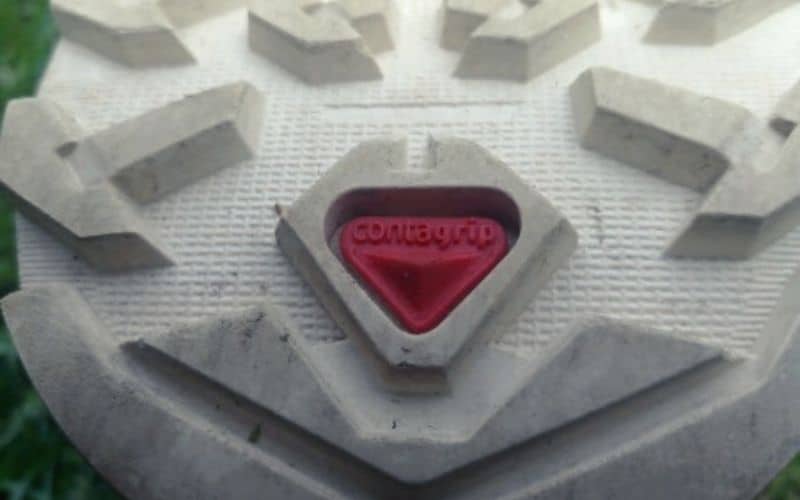
Because some manufacturers tailor the design of each shoe for specific brands or uses, Vibram models should not all be treated as equal. Those designed for serious grip in the mud (e.g. Vibram MegaGrip) have larger lugs while models designed for scrambling over rocks prioritize sticky rubber (e.g., Vibram Dynamis).
Weight
If you’re in the market for lightweight hiking shoes, weight is likely a top priority. All of the hiking shoes featured above fall into the “lightweight” category of shoe. However, the difference between the lightest shoe on our list (Altra Lone Peak 7, 1 lb. 6 oz.) and the heaviest (Keen Targhee III, 2 lbs.) is significant, and that 10-ounce difference could translate into a serious disparity in performance.
But not in the way you might expect…
While it might seem logical that heavier hiking shoes will be the burliest and most durable, the opposite is often true. The toughest shoes on our list are the La Sportiva TX4, which weigh just 1 lb. 10 oz. Other tough lightweights include the La Sportiva Spire and the Salomon X Ultra 4. The Moab (1lb. 15 oz.), on the other hand, are among the least durable on our list.
The take-home? Gauge every shoe on a case-by-case basis, paying close attention to the materials used in the upper and midsole and checking if there’s a protective rand. Shoes with rands, leather/suede uppers, and a TPU midsole are often heavier, but also more durable. Knowing that a shoe that’s rand-free, mesh-rich, and has an EVA midsole might tear or disintegrate over time may make you rethink the importance of a few ounces.
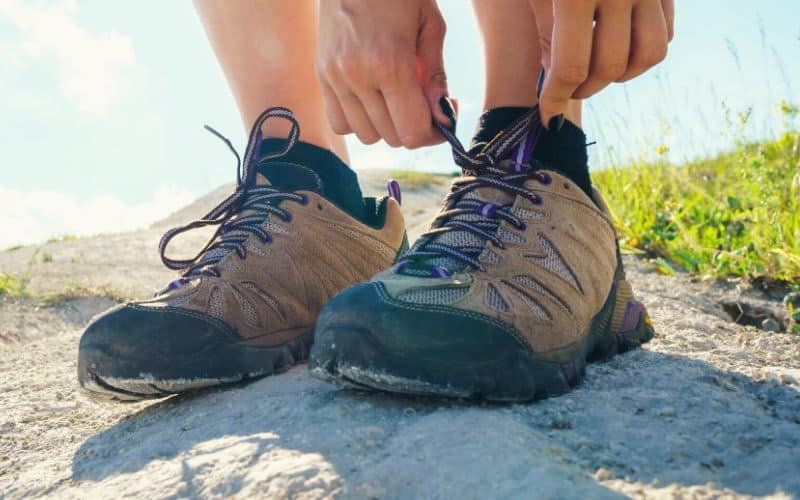
Only plump for an ultralight shoe if it ticks all the other boxes on your priority list and you’re especially keen to reduce leg fatigue by shedding weight from your feet.
Materials
The ideal trekking or hiking shoes are those made with durable materials that let them withstand a little bit of rough treatment on the trails without compromising breathability and comfort or adding too many ounces to their weight.
Only choose an ultralight shoe if it ticks all the other boxes on your priority list and you’re especially keen to reduce leg fatigue by shedding weight from your feet.
Waterproofing
If you plan on hiking in the mountains or during the wet season, choosing a pair of waterproof hiking shoes is a no-brainer. Nearly all hiking shoes can be made water-resistant by applying a DWR treatment post-purchase. However, buying hiking shoes that are designed for use in wet conditions is always likely to yield better results.
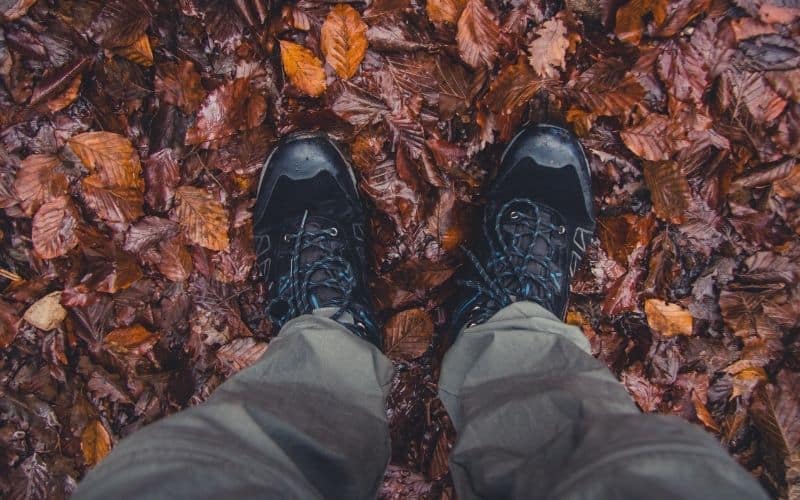
Waterproof hiking shoes use a waterproof-breathable membrane sandwiched between the outer and inner fabric of the shoes. This membrane provides far superior protection to DWR treatments and also saves you the hassle of having to reapply your DWR every few months.
The only downside to waterproof hiking shoes is that they usually cost considerably more and are a fraction heavier than their non-waterproof cousins.
Leather hiking shoes are naturally waterproof. However, you will need to apply a waterproofing treatment now and then to keep the level of protection high and leather is far less breathable than a high-quality membrane.
Breathability
If you’re choosing shoes for hiking hard or hiking in hot and humid conditions, breathability is key. Shoes that lack breathability will become uncomfortably sweaty and can lead to every hiker’s worst enemy…blisters.
Generally speaking, the most breathable hiking shoes are those with mesh uppers, and the least breathable are those with Gore-Tex membranes. Waterproof membranes may prevent liquid getting in, but they also hinder its ability to get out, which can result in sweaty feet wetting out your socks.
The one exception to this rule is found in the La Sportiva Spire, which uses Gore-Tex Surround, a more breathable variety of membrane that mitigates breathability issues.
Protection
Choosing a shoe with some form of toe cap (aka “toe rand”) is a wise decision if you’ll be hiking on anything other than mellow, well-maintained trails.
Some trail shoes come with a full rubber rand that encircles the entire shoe. However, most lightweight hiking models have a trimmed-down version that covers only the toe area.
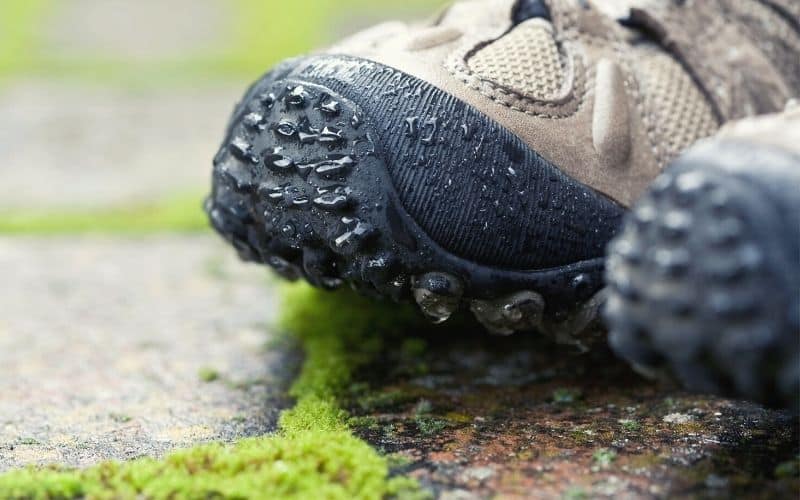
If you’re a scrambler or tend to hike on rougher trails, this “extra” is an absolute must. If you tend to hike on well-maintained trails only, then you could probably get away without one, but it’s always nice to have, just in case you stray into something hard while admiring the scenery.
Durability and Materials
Durability is a key factor to take into account when choosing your next hiking shoes. No matter where you plan on doing your hiking, the ideal hiking shoes are those made with durable materials that can withstand a little bit of rough treatment on the trails without compromising breathability and comfort or adding too much weight.
Two of the most durable materials or fabrics used in hiking shoes are nubuck leather and suede. Both of these are soft and supple, but also very hard-wearing and resistant to punctures, rips, and tears. They’re also naturally water-resistant.
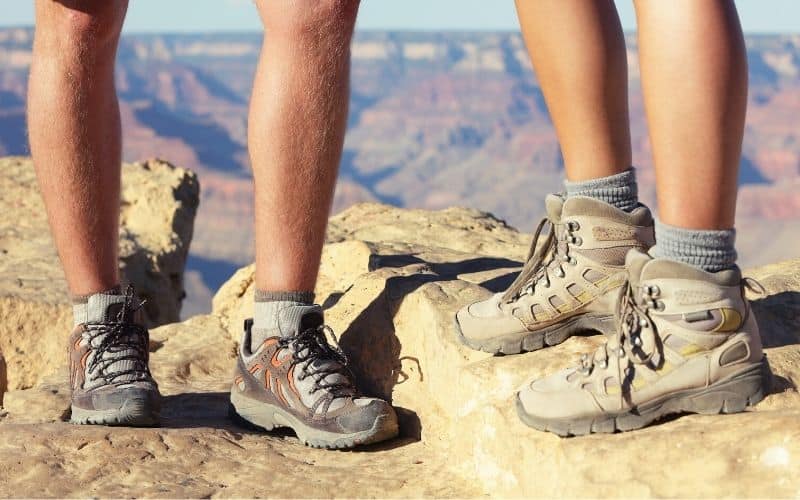
On the downside, both of these materials are heavier than the lightweight synthetics used in other models and not nearly as breathable.
The most breathable and lightweight hiking shoes typically use plenty of mesh or a combination of leather, suede, or nubuck and synthetic fabrics. While these are great for hikers who like to travel fast and light, and breathe well when you’re working up a sweat, they usually lack durability and are less water-resistant (unless that is, they use a waterproof membrane).
When weighing up the options, therefore, it’s best to know your priorities and what conditions you plan to do your hiking in.
Lacing Systems
Your shoes’ lacing system can have a large bearing on how practical, comfortable, and user-friendly they are.
The last thing you need is to readjust the lacing continually while on the trail. As such, it is essential that the lacing system isn’t susceptible to loosening. It needs to secure your heel well to prevent blisters and hotspots.
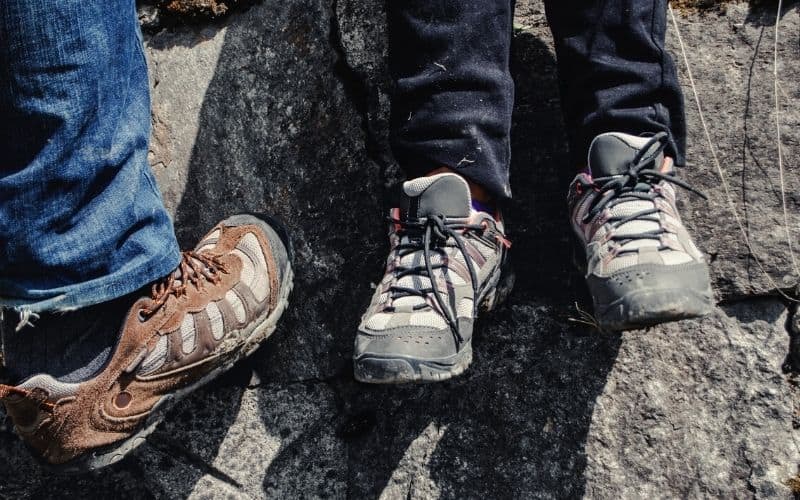
The single-pull lacing system used in shoes like the Salomon X Ultra is convenient and allows for an equally tight fit across the foot. However, it won’t be to everyone’s liking, and those who need to fine-tune their laces for a comfortable fit are better off avoiding this type of quick-lace system.
The Best Hiking Shoes for Men and Women: The Verdict
After much testing and deliberation, our standout favorite hiking shoes are the Salomon X Ultra 4. The X Ultra are everything a modern hiking shoe should be. They’re lightweight, reasonably tough, very grippy, and supportive enough for trickier trails of carrying heavy packs. They’re also among the most comfortable shoes we’ve ever had the pleasure of wearing.
If the X Ultra 4 are a little too pricey for your budget, the Vasque Juxt and Columbia Redmond are solid alternatives. Neither of these shoes are as lightweight or agile as the X Ultra, but they’re both very well made, comfortable, and offer enough in the way of performance for the needs of most hikers.
So, how did you like our article? If we missed anything or you have any questions, let us know! And if you’d like to share this post with your friends, please do!
